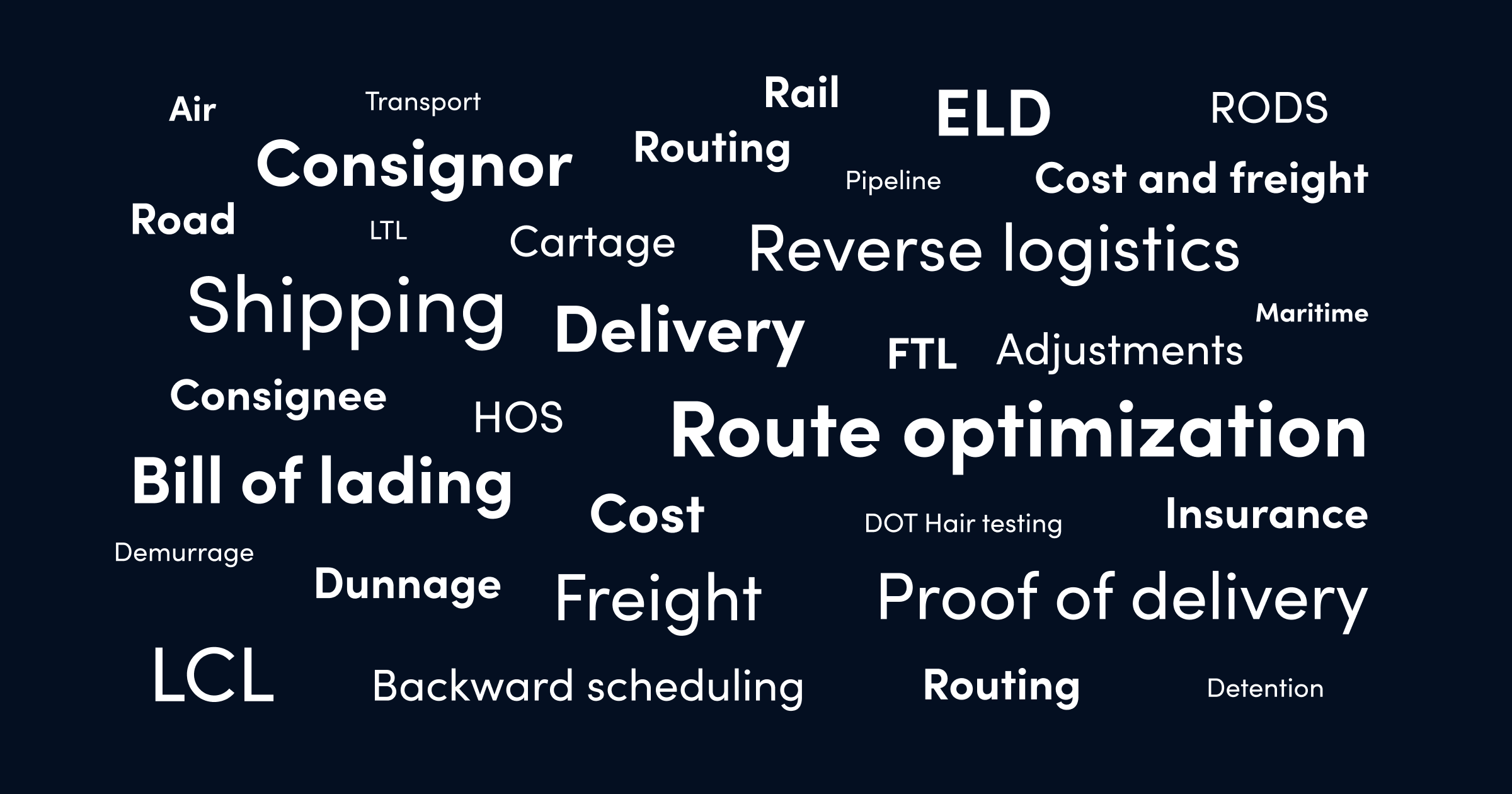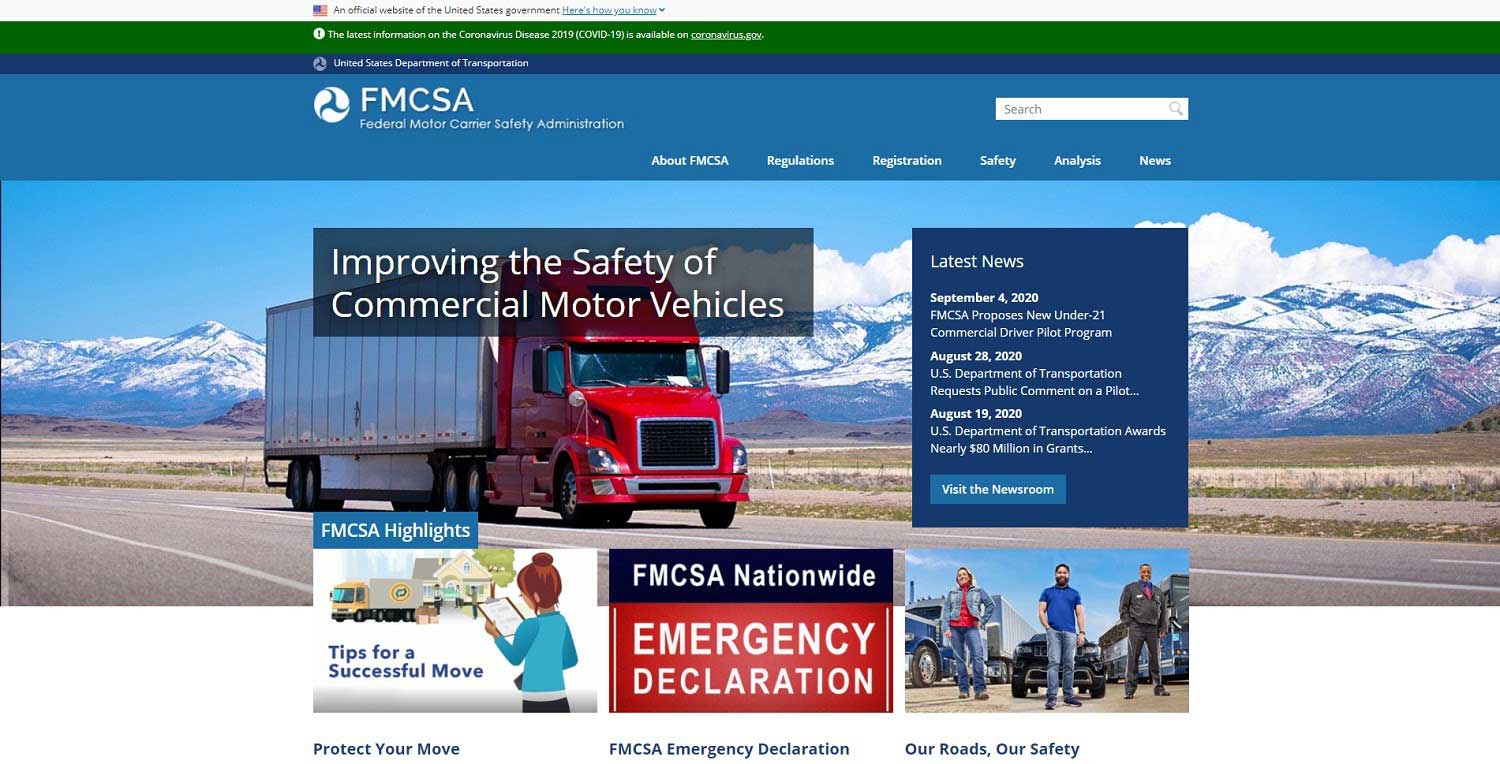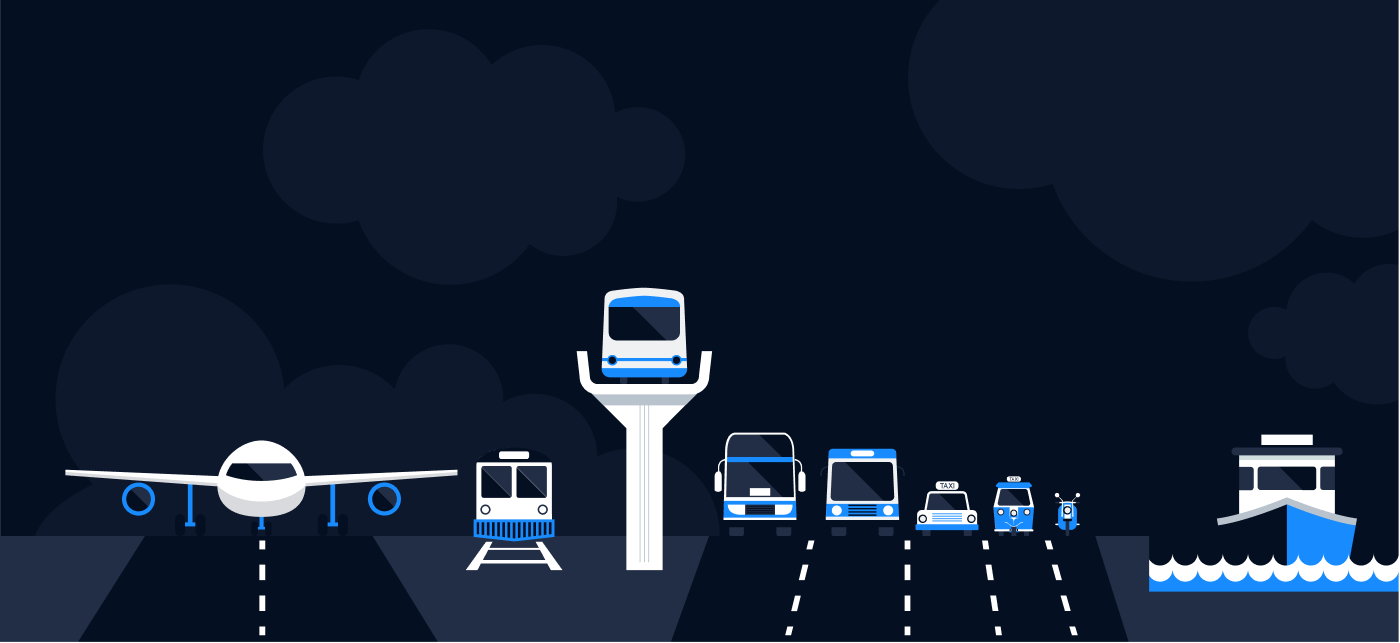Transportation Terms & Regulations You Need to Know

The transportation industry is full of jargon and can be hard to navigate.
A professional needs to know a ton of acronyms and complex transport terms to successfully navigate the waters and set up the best processes for their own company.
By reading and familiarizing yourself with these terms, you’ll be better equipped to manage logistics and negotiate the best deals for your company.
In this article, we’ll give you an in-depth walkthrough of the vital transportation terms that any business owner must know.
Let’s get started.
To navigate to the section which interests you the most, click below:
- 21 Transportation Terms Every Business Owner Should Know
- 5 Transportation Regulations for Trucking, Delivery, and Field Service Companies
- Six Most Common Modes of Transportation
- Improve Your Road Transportation Efficiency With OptimoRoute
22 Transportation Terms Every Business Owner Should Know
In this section, we’ll cover the most essential transportation terminology in alphabetical order.
Adjustments
Adjustments are the extra delivery costs or freight charges that incur if a package or delivery weighs more than originally estimated. Adjustments may also be added for other factors such as:
- Address changes
- Service changes
- Delivery date changes
- Etc.
Backward scheduling
Backward scheduling is when you plan manufacturing backward from the date of delivery (when your product reaches its final destination). It’s most valuable for businesses with made-to-order products or expirable deliverables, like food products or flower arrangements.

Bill of lading (BOL)
A bill of lading is a contract between a shipper and a carrier that covers every good or product included in the package, where it was loaded, and where it’s going. It must be signed by the carrier, shipper, and the receiving party.
Cartage
In transportation, cartage refers to the transportation of goods over a relatively short distance, for example within a town or commercial area.
Consignee
In simple terms, the consignee is the person who will receive the shipment. The ownership of the goods will transfer to the consignee when the cargo reaches its destination. They must sign the bill of lading when receiving cargo.
Consignor
The consignor is the person who sends the package to the consignee using a freight service. The consignor must sign the bill of lading when first shipping the cargo.
CFR (Cost and freight)
The CFR is a set of rules that regulate sea and inland waterway transport laid out in the Incoterms. Under these rules, the seller must clear the goods for export, deliver them to the ship at the port of departure, and pay for transport to the destination.
CIF (Cost, insurance, and freight)
CIF is another ruleset for sea and inland waterway transport laid out in the Incoterms. In addition to the CFR approach, the seller also pays for insurance coverage for the goods until it reaches its destination.
Demurrage
Demurrage fees are extra fees you have to pay when your cargo exceeds the planned time in a terminal. These will come in addition to your regular freight rates.
Detention
Detention fees are surcharges that occur when you use a shipping container longer than planned. For example, if the shipping of a cargo load gets delayed, and the container takes too long to return to the terminal.
Dunnage
Dunnage is essentially material that you use to eliminate gaps and secure cargo during transportation. Even with loads divided into pallets, you may need to use cardboard or pieces of wood to reduce movement and protect the goods.
Electronic Data Interchange (EDI)
Electronic data interchange refers to a computer-to-computer exchange of important shipping-related documents between shipping, freight, and carrier companies. Transportation companies use EDI protocols to share information on shipments like bill of lading, manifests, shipping status, and invoices
FTL (Full truckload)
An FTL load in transportation is a cargo load that’s large enough to fill out an entire truck. FTL carriers will only carry one dedicated load per truck, instead of multiple loads from different customers. A similar term, Full Container Load (FCL), refers to a cargo load that’s large enough to fill a shipping container on a maritime shipment.
Free On Board (FOB)
Free on board is a term that denotes the point in the transportation of a shipment at which the liability and ownership of the goods being shipped shifts from the seller to the buyer (this is called the FOB destination).
LCL (Less than container load)
LCL is a term used for international sea freight transport that refers to the buying and selling of parts of a container.
LTL (Less than load)
LTL is a term used in trucking to describe the practice of shipping less than a full truckload. LTL carriers piece up the transportation capacity of each truck and sell it to different shippers.
Proof of delivery (POD)
The proof of delivery is typically an email sent to the shipper that includes a package’s tracking number and an image of the recipient’s signature.
Reverse logistics
Reverse logistics refers to any part of your shipping process where goods move from the customer back to their origin. For example, if you sell water or other liquids in reusable containers, the return of those containers is part of reverse logistics.
Routing
Routing, or route planning, is the process of planning a delivery truck or transportation vehicle’s route for deliveries/drop-offs/pick-ups. It can have a great impact on your transportation efficiency and overall fuel usage.
Route optimization
Route optimization refers to the process of improving your shipping or delivery routes for better fuel and delivery efficiency. It can not only improve your mileage, but also reduce overtime costs, and boost your total shipping capacity.
Scheduling
In transportation and trucking, scheduling is all about managing incoming orders, and assigning workers to handle those orders on time. Doing this manually can be a huge managerial hurdle, and slow down your shipments and deliveries.
Transportation Management Systems (TMS)
A transportation management system (TMS) is a supply chain platform that businesses use to organize and streamline the transportation of goods or services. A TMS can help reduce the cost of freight, and is most commonly used by enterprise-level businesses.
5 Transportation Regulations for Trucking, Delivery, and Field Service Companies
The transportation industry is also heavily regulated, with many federal regulations that aim to protect the safety of all drivers on the road.
In the US, the FMCSA (Federal Motor Carrier Safety Administration) regulates the motor freight industry.

Let’s take a closer look at the individual rules and regulations.
DOT Drug & Alcohol Clearinghouse
The DOT’s Drug & Alcohol Clearinghouse is essentially a digital database of the drug and alcohol violations of any driver with a commercial driving license. Carriers in the US must check the Clearinghouse before making a hire, and annually for each employee thereafter.
ELD – Electronic logging device
The ELD mandate is a rule for long-haul trucking companies (and certain short-haul operations) that all trucks have to include electronic devices that log all driving hours of the vehicle.
HOS – Hours of service
HOS regulations mandate how many hours per day a commercial driver can remain on the road. Your drivers can’t exceed 11 hours of driving time per day, and cannot drive after the 14th hour of coming on duty. There’s also mandated 30-minute breaks after 8 hours of active driving.
RODS – Records of duty status
If your company is exempt from the ELD, your company needs to keep records of your drivers when they are on duty and driving. Your company must keep these records for at least 6 months after the recorded 24-hour period.
DOT Hair testing
DOT Hair Testing is a proposed rule that will mandate that motor carriers routinely drug test their drivers through testing hair samples. It’s expected to go into effect in the United States in late 2020 or early 2021.
Six Most Common Modes of Transportation

You may be wondering:
What are the main types of freight?
There are 6 different primary transportation services for raw materials and finished goods, taking place on the ground, on the ocean, and in the air.
Road transportation
Long-haul road transportation includes FTL & LTL shipping through trucking companies. Whether the carrier requires you to order a full truckload or uses consolidation to ship multiple loads depends from company to company. For countries with a large inland area, it’s usually the most important mode of freight transportation.
According to the American Trucking Association, trucking in the US alone generated $791.7 billion in revenue in 2019, 80% of which was handled by trucks.
Road transportation is also the mode most likely to be handling parcels and last mile delivery. You might use another mode of transport from the point of origin, but delivering a package to a customer’s door typically means driving on roads.
Maritime transportation
Cargo ships typically handle the international shipping of bulk cargo and large freight like vehicles, trucks, and other industrial goods and equipment.
Maritime transportation costs are typically much cheaper than air freight, but it can take up to several months to send a single shipment.
Tankers are also typically used to ship gasoline, oil, and other hazardous materials from country to country.
Air transportation
Air freight is typically used for time-sensitive packages. For example, fresh fish and caviar are usually flown from suppliers and shipped directly to restaurants to preserve the freshness.
Like maritime transport, air carrier transport is popular for international shipping, but mostly for small freight and parcels.
Intermodal transportation (Multimodal)
Intermodal or multimodal is when you mix different types of transportation to get your shipments from point A to point B as efficiently as possible.
It’s typically used by large enterprises to reduce supply chain costs.
Rail transportation
Rail transport is when you use trains and railways to transport goods. It’s typically used for large freight, and freight trains can be both domestic and international depending on the region. International rail transport is more common in European countries.
Freight trains are typically slower than trucks but can be a lot cheaper for large freight.
Pipeline transportation
The final model of transportation is pipeline, which transports oil & gas to and from refineries and also out to individual households, depending on the country and area.
Improve Your Road Transportation Efficiency With OptimoRoute
If you handle any aspect of road transportation in-house, whether that’s long-haul trucking, last mile delivery, or technicians driving to appointments, OptimoRoute can help.
Here are a few ways we do it.
1. Improve fleet efficiency and reduce costs with better routes
Smarter, more efficient routes will help you handle more shipments and deliveries with the same fleet. This will improve your bottom line, and even help you handle more orders and boost your revenue.
You’ll also save on the fuel costs and overtime costs from your inefficient routes and schedules.
2. Plan long-haul multi-day routes
Unlike most route planners, OptimoRoute supports long-haul routes with a unique starting point every day. This makes it a lot easier to handle a long-haul transportation operation than when mapping each route out manually.
3. HOS-compliant schedules and routes
OptimoRoute makes it easy to stay compliant with hours of service regulations. Our route optimization software automatically plans compliant schedules within the maximum allotted driving hours per day.
You can also set breaks at the driver level, and OptimoRoute will fit the break in naturally between deliveries.
4. Accounts for vehicle capacity and capabilities
OptimoRoute will also account for the vehicle’s capacity and capabilities when planning a route. For example, if an order requires refrigeration or a loading ramp, you can specify this in the order sheet, and OptimoRoute will only assign the order to a truck that matches the requirements.
5. Live tracking and ETA
Through our mobile app for drivers, you can track the location of all your motor vehicles with GPS in real time. This is great for dispatchers to deliver ETAs to customers, as well as forecast shipping capacities for the foreseeable future.
Final Thoughts
OptimoRoute helps transportation companies increase productivity (without any new hires) and save money on both fuel consumption and excess payroll from travel time.
It’s also easier to stay compliant and forecast the capacity of your fleet to handle freight with real time data on their locations and performance.
Start your 30-day free trial today and use OptimoRoute to boost your transportation efficiency.
Try OptimoRoute™ for Free
No installation or credit card required


